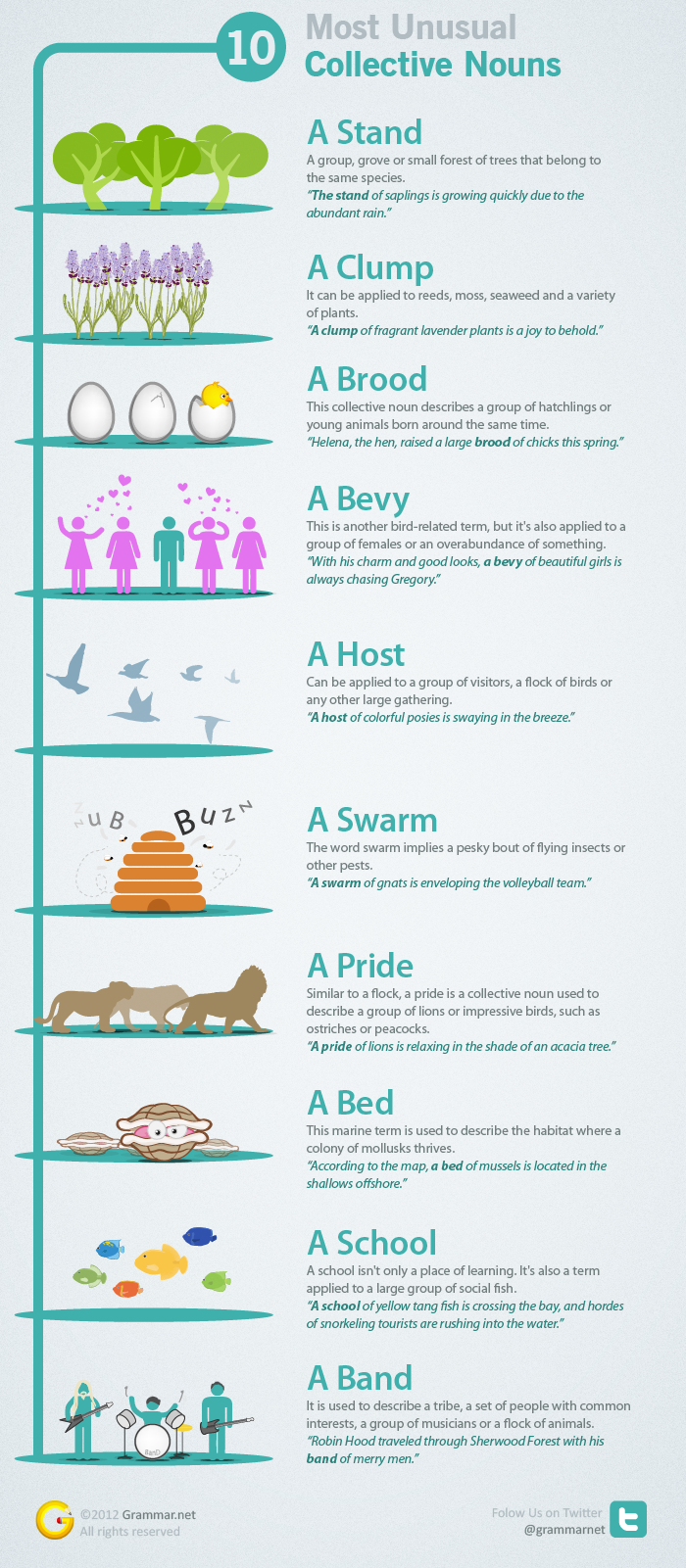Collective nouns are tricky because they’re applied to groups of things, but they’re treated like singular nouns. At this point, many people are wondering what are collective nouns, and how do they work? Notable examples of collective nouns include words like group or team that cover a number of people who are treated as a singular entity.
Animal groups in particular are associated with a variety of unusual terms included in this collective nouns list. Even items of clothing, such as a pair of pants or a pair of shoes, use collective nouns that require singular verb agreement. Here are 10 outlandish examples of collective nouns.
To download high-resolution poster click here
Embed this image to your site:
1.) A Stand
This versatile collective noun is used in botany, forestry and agriculture. It denotes a group, grove or small forest of trees that belong to the same species. A forester might say, “The stand of saplings is growing quickly due to the abundant rain.”
2.) A Clump
Often applied to plants, this botanical term denotes a cluster of tightly grouped stalks, plants or trees. It can be applied to reeds, moss, seaweed and a variety of plants. Here’s an example: “A clump of fragrant lavender plants is a joy to behold.”
3.) A Brood
Used in zoology and farming, this collective noun describes a group of hatchlings or young animals born around the same time. For example, “Helena, the hen, raised a large brood of chicks this spring. Farmer John is expecting a second brood this summer.”
4.) A Bevy
This is another bird-related term, but it’s also applied to a group of females or an overabundance of something. An observer might say, “With his charm and good looks, a bevy of beautiful girls is always chasing Gregory.”
5.) A Host
Famously used in William Wordsworth’s poem about daffodils, this versatile collective noun can be applied to a group of visitors, a flock of birds or any other large gathering. Here’s an example: “A host of colorful posies is swaying in the breeze.”
6.) A Swarm
The word swarm implies a pesky bout of flying insects or other pests. It’s also a verb that denotes a cloud of flying bugs. When referring to insects, one might say, “A swarm of gnats is enveloping the volleyball team.”
7.) A Pride
Similar to a flock, a pride is a collective noun used to describe a group of lions or impressive birds, such as ostriches or peacocks. Here’s an example: “A pride of lions is relaxing in the shade of an acacia tree.”
8.) A Bed
This marine term is used to describe the habitat where a colony of mollusks thrives. It is often applied to clams, mussels, oysters and similar bivalves. For example, a marine fisherman might say, “According to the map, a bed of mussels is located in the shallows offshore.”
9.) A School
A school isn’t only a place of learning. It’s also a term applied to a large group of social fish. Here’s an example: “A school of yellow tang fish is crossing the bay, and hordes of snorkeling tourists are rushing into the water.”
10.) A Band
This collective noun is exceptionally versatile. It is used to describe a tribe, a set of people with common interests, a group of musicians or a flock of animals. For example, “Robin Hood traveled through Sherwood Forest with his band of merry men.”
These collective nouns are just a few of the odd English words that are used to describe groups of people, animals or plants. If there is a particular collective noun you like or one you find confusing, share it in the comments area.






